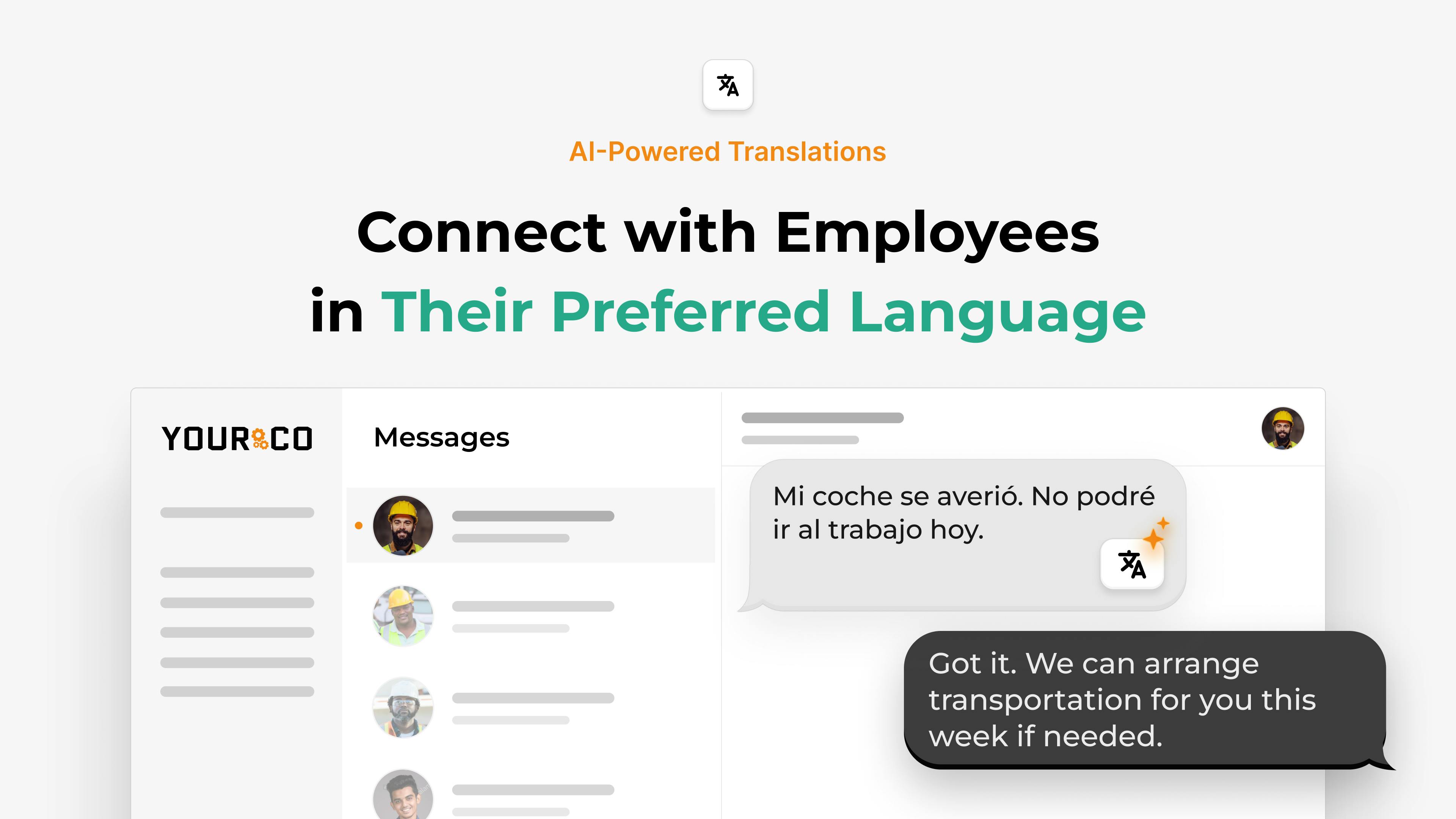How to Deliver Compliance Training for Spanish Workers


Clear compliance training helps every worker stay safe and follow protocols confidently. But when training materials arrive only in English, Spanish-speaking employees face unnecessary barriers that slow them down and put them at risk. These language barriers create gaps in safety across industries where Hispanic workers make up significant portions of the workforce, such as construction, manufacturing, warehousing, and food services, leaving companies vulnerable to violations and workers without the information they need to protect themselves.
Training in Spanish helps everyone succeed. It makes safety rules easier to follow, policies clearer, and employees more confident in their roles. It also creates stronger records for audits and reduces the chance of violations.
The six steps ahead explain how to translate materials clearly, deliver reminders in the right channels, and confirm comprehension so your whole workforce stays safe and compliant.
1. Translate Training Materials Clearly
When translations miss the mark, the stakes are high. Misread lockout procedures or unclear harassment policies can lead to fines, lawsuits, and injuries.
The fix starts by recognizing what workers want. Research shows that 88% prefer training in their native language because it boosts both understanding and retention. Give Spanish speakers information in Spanish, and you remove the guesswork that slows them down or puts them in harm's way.
Here's how to get it right:
- Partner with professional translators who understand compliance terminology to ensure proper legal meaning.
- Adapt everything (slide decks, manuals, even break-room posters), so examples, images, and phrases feel familiar to a Mexican warehouse crew or a Puerto Rican housekeeping team.
- Use AI-powered translation tools to support consistency across materials, especially for repeat updates or multi-location rollouts. These tools help ensure technical terms like ''bloqueo y etiquetado'' or ''procedimiento de reporte'' stay aligned every time.
- Run a native-speaker review before launch, then pilot the course with a small group of Spanish-speaking workers to catch unclear sections early.
Plain language matters just as much as perfect grammar. Many frontline workers read at different literacy levels, so keep sentences short and avoid legalese. Replace "pursuant to policy subsection 4" with "según la regla 4" and use visuals to show each step.
When content feels straightforward, engagement rises, and you can be confident everyone leaves the room (or the job site) on the same page.
2. Send Training Alerts That Reach Every Worker
Spanish-speaking employees are far more likely to notice compliance reminders when they arrive by text instead of email. Text messages stand out because almost everyone reads them right away. SMS has a 98% open rate, with most messages opened within 90 seconds. Email, on the other hand, often gets buried in crowded inboxes for hours.
SMS works because every mobile phone can receive a text, so workers on construction sites, production lines, or hotel floors don't need Wi-Fi, app downloads, or company email access. Texts also arrive in the same place employees communicate with family and friends, making alerts feel familiar and hard to ignore.
Put yourself in your crew's boots. An inbox in English might get skimmed after a long shift, but a bright notification buzzing in Spanish grabs attention immediately:
"Recordatorio: Capacitación de seguridad mañana a las 8:00 a.m. en la sala de reuniones."
It's short, specific, and instantly actionable. When a worker can't make the session, replying takes seconds. You see the conflict in real time and can reschedule without playing phone tag. Email can still host longer policies, but relying on it for time-sensitive notices leaves too much to chance, especially for deskless staff who may not check corporate accounts daily.
3. Schedule Spanish-Language Training Sessions Instantly
Building on the power of text messaging, Spanish-speaking workers show up when training fits their shifts, arrives in their language, and lands where they will see it.
Many miss sessions because notices come in English, arrive late, or get buried in crowded or unused inboxes. Using SMS messages delivers superior engagement rates, ensuring your team members see your messages. And when you send every reminder in clear, plain Spanish, they understand them too.
Simply include the date, time, location, and a simple way to answer back:
"Recordatorio: Capacitación de seguridad este jueves a las 2 p.m. en la sala de juntas. Responda 1 para confirmar o 2 si necesita otro horario."
Since SMS works on any phone, even crews that don’t have email still get the alert. Quick replies let you spot conflicts early and line up make-up sessions without chasing people down.
Segment your lists so only the right teams get each reminder. Night-shift welders at Plant B should not receive a 6 a.m. invite meant for day-shift packers at Plant A. Tailored messages cut confusion, reduce no-shows, and show respect for each worker's time.
Follow up on a set schedule: a day before, a one-hour heads-up, and a final "training starts now" nudge. Short, timed nudges keep the session top of mind without overwhelming employees.
4. Confirm Understanding with Two-Way Messages
Don't stop at "training delivered." Two-way messages in Spanish let you test comprehension on the spot and fix gaps before they become accidents.
One-way channels, such as slide decks and printed manuals, assume workers absorb everything the first time. In reality, questions often arise after class, and many Spanish-speaking employees may hesitate to ask for clarification. When answers never surface, mistakes follow. Opening a feedback loop solves this problem.
Text messaging makes checking understanding fast and simple. A simple SMS poll like: "¿Entiende los pasos correctos para reportar un accidente? Elegir SÍ o NO." goes straight to each worker's phone. You see who responds "NO", then follow up with a quick refresher or a call. Since the exchange happens in Spanish, employees skip the challenge of translating safety terms and often answer more honestly.
Platforms like Yourco that support two-way communication also store every response, giving you a clear record for audits and a roadmap for future coaching. Send a Spanish poll, read the answers, and close the loop. When employees can ask questions in real time through text, comprehension rises and repeat violations drop.
This approach also builds trust. Inviting workers to speak up without a classroom spotlight shows respect for their knowledge and language. Over time, that respect fuels engagement. Employees who feel heard are more likely to finish modules, follow rules, and alert you to risks.
5. Document Training for Audit Compliance
Training only counts if you can prove that workers received, understood, and completed it. A clear paper trail, digital or physical, protects you in audits and shows your Spanish-speaking team that their safety is taken seriously.
Agencies like OSHA and HIPAA expect documentation to be retained for years, sometimes even decades. While rules vary, the principle is the same: records must exist and be easy to retrieve. Providing Spanish versions ensures employees understand the training and helps meet the expectation that information be delivered in a way workers can grasp.
Here's what most companies include in their documentation systems:
- Attendance logs with names, dates, and course titles (in English and Spanish).
- Copies of content such as slide decks, videos, handouts, or signage.
- Signed attestations (digital or handwritten) confirming "Yes, I understood."
- Knowledge checks, like quiz scores or short tests, to show comprehension.
- SMS records of Spanish reminders, polls, or follow-ups. Store these alongside formal materials, with exportable transcripts that include date, time, and mobile number.
Keep a complete record set per employee, with English and Spanish versions stored together. Back everything up in a secure, searchable system. This makes audits faster, helps reduce compliance risk, and shows your Spanish-speaking crew that their training and their safety matter.
6. Reinforce Training with Regular Reminders in Spanish
One training session won't stick unless you keep the message alive. Companies that overcome language barriers and continually refresh compliance content often experience fewer violations. Clear Spanish reminders paired with your initial training keep safety front and center, reduce errors, and show your team you've got their back every shift.
Keep each reminder short, specific, and clear: "Recuerde usar su casco de seguridad antes de entrar al área de trabajo."
Rotate topics so they stay fresh. Send a hard-hat reminder today, a note about reporting near-misses tomorrow, and a harassment policy refresher next week. Rotating these messages prevents workers from tuning out and covers more ground.
Timing also makes a difference. Schedule texts at shift start or just before high-risk tasks. Make sure night-shift workers don't get pinged at noon and warehouse teams don't receive office safety tips.
You can invite quick check-ins that encourage workers to ask questions: "¿Tiene preguntas sobre el nuevo procedimiento de bloqueo/etiquetado? Responda SÍ para que un supervisor le llame."
What’s more, every reply becomes documentation that you're actively reinforcing training. Workers build lasting safety habits, and you have an ideal channel for reaching every frontline worker.
Deliver Training That Reaches Every Worker with Yourco
When you deliver compliance training in Spanish, everyone wins. Workers stay safe, you stay compliant, and audits run smoother. Clear content is only half the battle; you also need a reliable way to get it in front of every employee, every time.
Yourco makes this simple. Our AI-powered translations cover more than 135 languages and dialects, so managers can type once and send accurate Spanish messages. No outside translators, no long waits, no copy-and-paste errors. SMS alerts reach workers instantly, so safety reminders and deadline notices get seen instead of getting buried in email inboxes.
Need proof that the lesson stuck? Yourco's polls and surveys gather instant responses. You can spot gaps and follow up before small issues turn into violations. Every message, confirmation, and quiz result gets saved automatically, giving you a clear audit trail without hunting down paperwork.
No app downloads, no internet required — just simple texts that reach flip phones and smartphones alike. With Yourco, HR and operations leaders can be confident that every Spanish-speaking worker is informed, engaged, and fully documented without adding another tool to their plate.
Try Yourco for free today or schedule a demo and see the difference the right workplace communication solution can make in your company.
Frequently Asked Questions
How can I confirm Spanish-speaking workers received training alerts?
SMS shows you exactly who got your message. You'll see delivery receipts for every text that reaches a phone, and you can ask for a simple confirmation — "Responda SÍ para confirmar." When you combine those receipts with response tracking, you know who opened and replied to your message. Keep those receipts and replies in your compliance files to show auditors that workers received proper notice.
Do I need to hire a translator for every message?
Not for everyday alerts. Save professional translators for complex policy documents where legal details matter. For routine training reminders, Yourco's AI translation handles Spanish automatically. You write your message once, select "Send in Spanish," and the system creates a clear version workers understand — no waiting, no extra cost. This approach lets you use human translators for complicated material while keeping daily reminders flowing fast.
Can SMS be used for both reminders and quizzes?
Yes. Texts work great for quick nudges like "Capacitación de seguridad mañana a las 8 a.m." but they also handle simple knowledge checks. Send a one-question quiz like: "¿Cuál es el primer paso del bloqueo/etiquetado? A) Avisar B) Cortar energía C) Inspeccionar." Workers reply with a letter, and Yourco records their answers right away. If someone answers wrong, you can automatically send extra resources to help them understand before the next audit. You can also use Yourco’s built-in polls to collect responses, making it easy to gather feedback or check comprehension across the whole team.
What if workers don't have smartphones?
No problem. Any phone that can receive a text will get your alerts, quizzes, and confirmations — no apps, data plans, or special logins needed. This matters for transportation, construction, manufacturing, and hospitality teams where some employees still use basic flip phones. By sticking with regular SMS, you remove tech barriers and make sure every Spanish-speaking worker gets the same timely information, no matter what kind of phone they carry.




